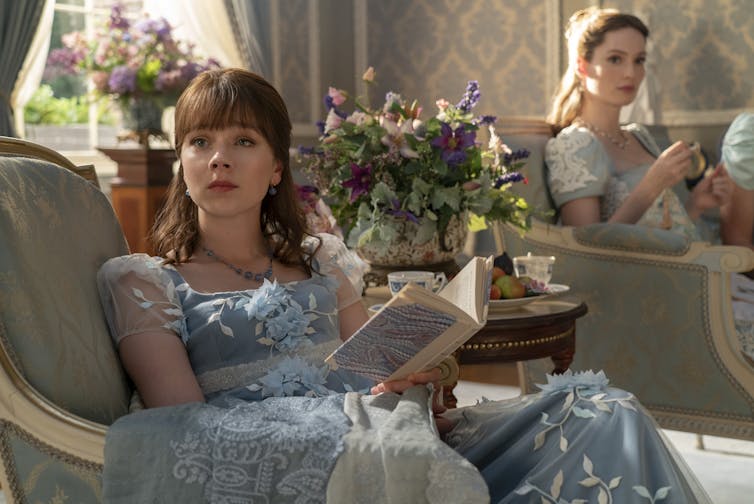 |
| Netflix |
Television producer and screenwriter Shonda Rhimes has come a long way since being a scriptwriter for the 2002 film Crossroads.
Her production company Shondaland now shines in its delivery of romance shows, with Bridgerton (on which she is an executive producer) being a major recent success. With season three hitting Netflix tomorrow, it wouldn’t be a surprise if Shondaland landed another surefire hit.
Rhimes understands romance as a technical art form. But beyond that, she shows us love doesn’t necessarily always exist between two people; it also exists between people and their passions, and in the way they view themselves.
The art of romance
First airing in 2005, Rhimes’ debut primetime TV series Grey’s Anatomy (still in production today) leaned heavily into the soap opera elements of romance and drama.
Rhimes masterfully executes romance in a contained setting – whether it’s a hospital, a social season in Regency era London, a Seattle firestation, or the political scene of Washington DC.
She also upholds one of most important characteristics of soap opera: there shall be no ending in sight. We’re still following Meredith Grey’s love life from that first fateful meeting with McDreamy, dropping in even now to get updates about her and Nick.
In Bridgerton, viewers have waited with bated breath for Colin and Penelope’s union. Will their relationship reach its climax in season three? Rhimes’ ability to effectively carry such story lines is what keeps us coming back.
Bridgerton’s spinoff Queen Charlotte also delivers the show’s backstory in a way that frames it as having no end and no set beginning.
Marrying familiar with foreign
The romance genre is often relegated to two categories: romantic drama or romantic comedy.
Both, unfortunately, may be perceived by audiences and critics as being “for women” and largely lowbrow. However, the key characteristics of romance afford audience as much a sense of connection as any other celebrated genre.
Romance tends to follow a narrative “masterplot”. This predictable structure emulates the natural milestones of a relationship: meet someone, fall in love and live happily ever after.
But the narrative may also include a range of difficulties, such as love triangles, unrequited love or forbidden love. The obstacles tend to cover such a range that viewers will likely identify with at least one.
This balance of predictability and conflict allows the viewer to escape into an exciting fantasy, while also knowing all will end well (or that even if the couple doesn’t end up together, it will still be the “right” ending).
In any given Shondaland series, there are multiple masterplots taking place simultaneously. These are often at different milestones, and staggered across the season (or multiple seasons).
Bridgerton’s period-setting helps enhance the tribulations faced by the characters. It adds to the escapism, while depicting all-too-familiar relationship issues.
Music is the key
One way to put viewers in characters’ minds is through the use of music, and Rhimes does this expertly.
Incorporating a recognisable music track can add more layers to an already emotional scene. One example from Rhimes’ early years is the use of Snow Patrol’s Chasing Cars in the Grey’s Anatomy season two finale.
The track features alternating musical notes that build aural tension, echoing the visual juxtaposition of formal wear/frivolity with the coolness of the hospital.
Izzy’s confession confirms her love for Denny while also destroying her career. The questioning lyrics, “would you lie with me?”, are heard as Meredith decides between two suitors. These visual and aural signs strengthen an already emotional scripted narrative.
Five years later, Rhimes references this scene once more in the show as Dr Callie Torres fights for her life (and her unborn child’s).
In an out-of-body experience, Callie sings the lyrics to Chasing Cars and her colleagues join in. This time, however, the focus is on the lyrics as they communicate the characters’ heightened emotional state.
Bridgerton also excels in using modern music in a period setting, by incorporating classical covers of chart-topping hits. These tracks are carefully placed to help communicate characters’ feelings.
In previous seasons, viewers will have recognised Madonna’s Material Girl, Alanis Morrisette’s You Oughta Know and Miley Cyrus’ Wrecking Ball.
Season three will bring a fresh lineup of covers including Billie Eilish’s Happier Than Ever, BTS’s Dynamite, Sia’s Cheap Thrills and Taylor Swift and Lana Del Rey’s Snow On The Beach.
In love with the craft
While romantic plot points are often at the heart of Rhimes’ shows, these aren’t always between a couple. Rhimes has always placed a focus on women who love their work and find a sense of romance in it.
In Scandal, Olivia Pope says, “I am very good at what I do. I am better at it than anyone else.” And while her torrid romance with Fitz spans the series’ entire seven seasons, she is not defined by it. Similarly, in How to Get Away with Murder, Annalise Keating is a troubled yet future-proofing mentor to her students.
Rhimes’ viewers are always following principal characters loving their work, their mentees and their legacy.
Even Bridgerton’s Queen Charlotte shows a commitment to the “work” of romance by identifying the most flawless debutante of the coming season. Through this process she reinforces her ability and authority as a matchmaker.
Viewers also share in Lady Whistledown’s immense pleasures of publishing. Julie Andrews’ narration highlights the absolute joy Whistledown feels in scouting, writing and delivering gossip.

Two decades ago, romance plots tended to feature a protagonist with a fabulous big-city job (often in publishing), but their occupation would come second to the goal of finding “the one”. How to Lose a Guy in 10 Days, Never Been Kissed and 13 going on 30 are just some examples.
Meanwhile, in Shondaland, a romance masterplot can be superseded by the trials and tribulations of a woman’s career and her journey of self-fulfilment. The joy of escapism now twists into watching women excel in their own right alongside the expectation of the happy ending, or at least the “right” ending.
It’s no wonder we’re still hanging around for Rhimes’ stories in 2024.![]()
Rebecca Trelease, Senior Lecturer in Communication Studies, Auckland University of Technology










.jpg)


